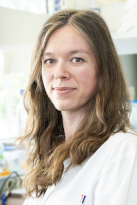 Louise Benarroch is a post-doctoral researcher in the “Myomatrix & Myonucleus Related Diseases: Genetics & Pathophysiology” team led by Gisèle Bonne in the Institute’s CRM. Her latest work on the characterisation of a cellular model for muscle diseases was published* at the end of August, and was also presented at the 28th International Congress of the World Muscle Society (WMS, 3-7 October 2023 in Charleston, USA), where it was awarded the Elsevier Runner Up Prize for 20 posters out of more than 400 presented. Interview with Louise Benarroch.
Louise Benarroch is a post-doctoral researcher in the “Myomatrix & Myonucleus Related Diseases: Genetics & Pathophysiology” team led by Gisèle Bonne in the Institute’s CRM. Her latest work on the characterisation of a cellular model for muscle diseases was published* at the end of August, and was also presented at the 28th International Congress of the World Muscle Society (WMS, 3-7 October 2023 in Charleston, USA), where it was awarded the Elsevier Runner Up Prize for 20 posters out of more than 400 presented. Interview with Louise Benarroch.
Can you describe the background to your work?
I’m working on DNA and I’m trying to understand the clinical variability linked to mutations in the LMNA gene coding for lamin A/C, i.e. why one patient is more severely affected than another, despite carrying the same mutation in this gene. To do this, the team and I collected as many biological samples as possible – muscle biopsies and cell lines – from cohorts of patients with a fairly frequent mutation, to obtain as much material as possible for research. Through national and international collaborations, it turned out that most of the cell types collected were fibroblasts derived from skin biopsies. To enable us to work on muscle, we needed to ‘transform’ these skin cells into muscle cells. We discussed this with the Myoline** cell line platform at the Research Centre, which has a cell model that enables the differentiation of fibroblasts into muscle-type cells, exactly what we needed.
How did you use this model?
We first characterised the model to find out its limitations. First we looked at the phenotype, then we went deeper and analysed the transcriptome and compared all the gene expressions of these cells with those of the muscle cells. Going even deeper, a collaboration with Philippe Collas’ team, who work in Norway at the University of Oslo, enabled us to also look at the organisation of DNA, i.e. the arrangement of chromatin, and more particularly LADs (Lamin Associated Domains)*** which are the areas of interaction between lamins and chromatin.
What results did you obtain?
We made a comparison between our myotubes – our differentiated muscle cells – and our myoconverted fibroblasts – fibroblasts differentiated into muscle cells – and looked at whether or not the organisation of the LADs was similar, and if so, up to what level, and finally how this influenced the conclusions we obtained. Although myoconverted fibroblasts acquire some of the characteristics of myoblasts, they retain some of the characteristics of fibroblasts. In fact, the two cell types do not reach the same stage of myotube differentiation.
For example, just by glancing at them, we can see that fibroblasts, which are uninucleated cells, gain, via the myo-conversion process, the ability to fuse and form polynucleated cells, like myoblasts. They therefore acquire an obvious phenotype, but in fact the differentiation is not as advanced. For the same differentiation time, there is a delay compared with myotubes, which is probably due to the differentiation system. In fact, myogenesis is a complex phenomenon involving a very large number of differentiation factors following a fairly precise chronology, and we bypass some of them to force the programme by adding a large quantity of a particular factor which allows differentiation but not complete differentiation.
What conclusions have you drawn from this and what are the next steps?
In the article, we set out the limitations of the model using fibroblasts from healthy subjects, but we now know that it can be used to open up avenues and study hypotheses, to get an idea of what is happening in muscle cells, but without being able to draw any major conclusions: it is still necessary to go back to muscle cells. We are going to begin studies on fibroblasts from cohorts of patients, initially carrying the same LMNA gene mutation, and then we want to extend this to several different mutations. The idea is to go further in analysing the pathophysiological mechanisms of these mutations.
Ultimately, the aim is to develop therapies that are tailored to individual patients, depending on the type of mutation, for example, and to be able to predict the severity of a patient’s condition fairly quickly so as to be able to fine-tune treatment.
** The MyoLine platform at the Institute of Myology is directed by Vincent Mouly. It provides immortalised lines of myoblasts and fibroblasts converted into muscle cells. The model used in this research was described in 2009 by the platform, but had not previously been studied down to the level of chromatin organisation.
*** Gisèle Bonne’s team is working on laminopathies, diseases caused by mutations in the LMNA gene, which codes for lamins, nuclear proteins that form the nuclear lamina, a structure located just below the nuclear envelope. We know that this nuclear lamina interacts directly with chromatin and regulates its organisation via the LADs.
